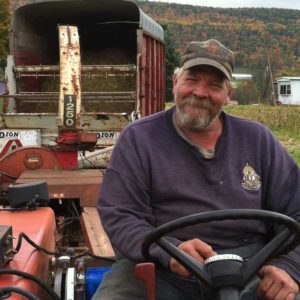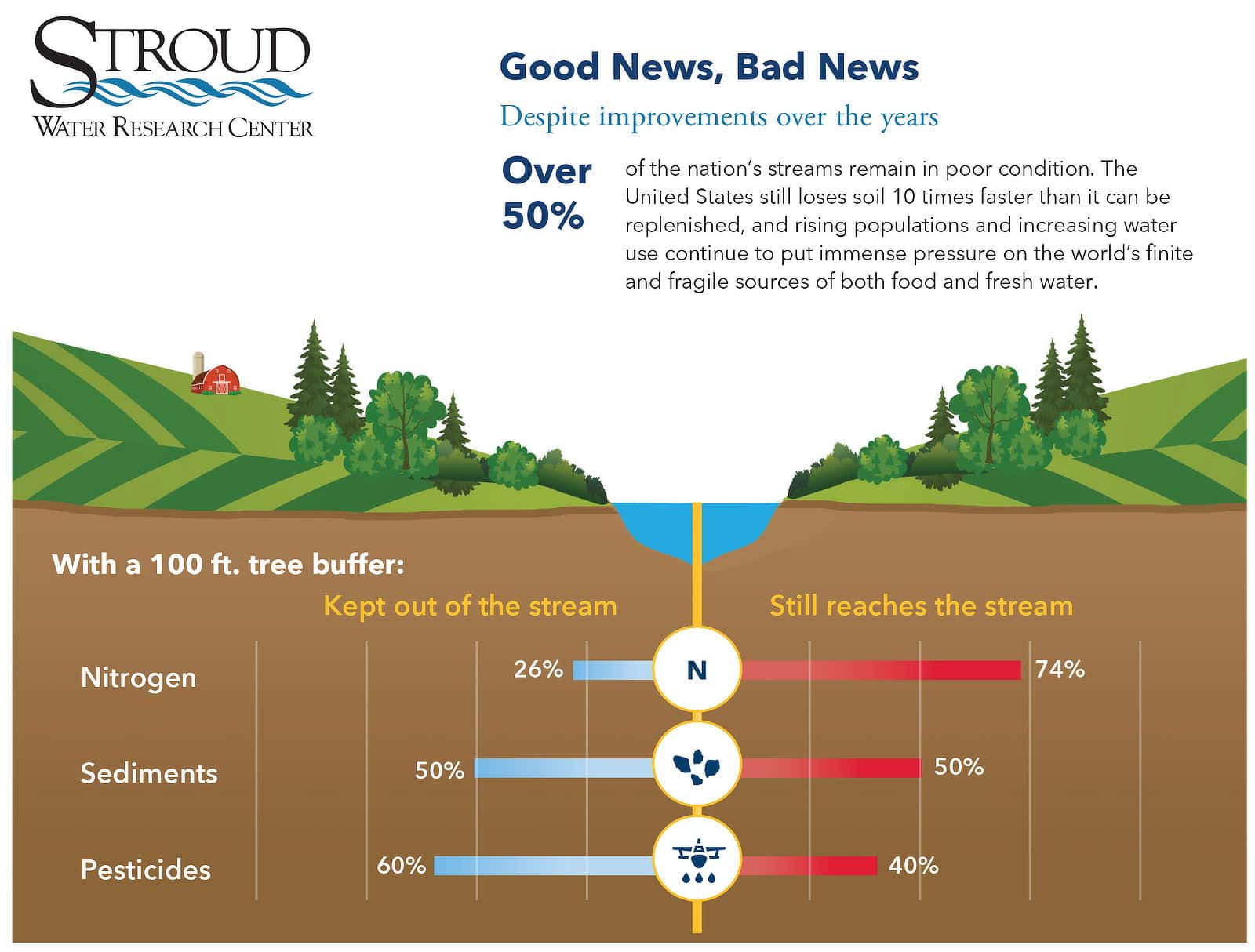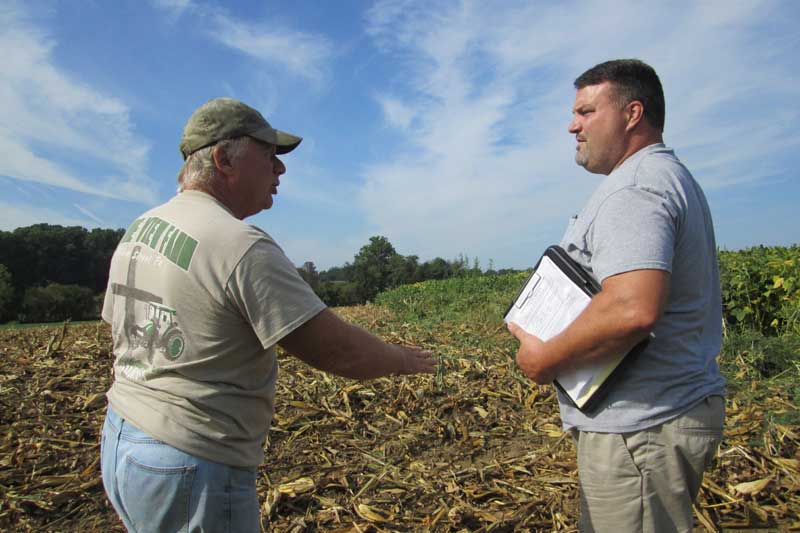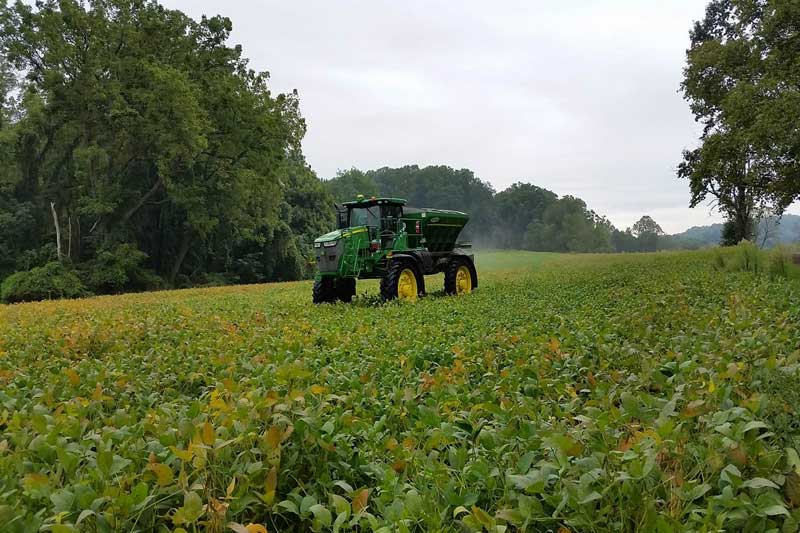By James G. Blaine
This is one of those good news stories.

Several years ago, Bern Sweeney met a farmer named Gabe Brown who had introduced multispecies cover cropping on his Midwestern farm in the hope of increasing his crop yield and improving his bottom line. Brown lives in a region of the country that averages only about 11 inches of rain a year, a fact that had historically required him and other farmers to spend a lot of money on irrigation, synthetic fertilizers, and pesticides. Then he began to look more closely at the native prairie beyond his fields, and he noticed that it regularly produced a variety of healthy plants without the benefit of irrigation, fertilizers, or pesticides; and he thought, “I wonder what would happen if I tried that?” So he began to grow his corn in a setting that mimicked the prairie, gradually weaning his land from its manmade dependence on irrigation, pesticides, and synthetic fertilizers. Not long thereafter, he was producing the same volume of crops at a vastly reduced cost and “making more money than I’d ever imagined.”
“And I’m sitting there,” remembered Sweeney, “thinking, ‘wow!’ What are the three biggest issues in stream ecology: sediment [from runoff], nutrients [from fertilizers], and pesticides. If we really want to make a difference throughout the system, from headwater streams to, say, the Chesapeake Bay dead zone, it would take something like multi-species cover cropping applied to all farm fields. This could be a game changer.”
Sweeney was open to Gabe Brown’s message. For the last 50 years he and other scientists at Stroud Water Research Center have demonstrated the connection between good land-use practices and clean fresh water, between healthy soil and healthy water. That connection was the foundation of the River Continuum Concept, the first unified hypothesis about how streams and their watersheds interact. As they analyzed the results of their long-term studies in the White Clay Creek watershed, Stroud Center scientists realized that pollutants often traveled a long way to the streams, and so they began to implement preventive measures farther away from the stream itself.
Every Square Meter of Land in a Watershed Affects the Stream Into Which It Drains
In 1982, Sweeney and then director Robin Vannote planted one of the first forest buffers to impede the enormous volume of topsoil that was eroding from upland cornfields and making its way into White Clay Creek — and subsequent studies have made streamside forests a best management practice for protecting streams and rivers from soil-borne pollutants.
Eighteen years later, Stroud Center researchers embarked on a six-year project, which concluded that the most efficient and effective way to protect New York City’s drinking water was to preserve watersheds as much as 100 miles away. Not only runoff over ground imperils streamwater: Laurel Standley’s studies at the Maritza Biological Station in Costa Rica found pesticides in the water, in the soil, and even in the bark of trees, which had originated in sugar fields on far-off Caribbean islands and had been carried hundreds of miles in the clouds.
It seemed that the farther the researchers moved from the stream, the more they realized how much its health ultimately depends on taking care of often-distant landscapes. Moreover, the farther away they moved, the larger the area they had to consider, which systematically confirmed what they had intuitively known: that every square meter of land in a watershed affects the stream into which it drains and that the impacts multiply as streams merge into rivers and ultimately end in the ocean. Finally, as the Watershed Restoration Group’s David Wise wrote last year, “the same biological principles — nurturing the microbes and other organisms that do the real work — apply to achieving both healthy soils and healthy streams. Farmers sympathetic to soil health will understand the importance of forested buffers to streams. Stream health proponents will realize more profoundly that healthy soils in the entire watershed are a great ally for clean streams.”
Just as a stream is not simply a pipe for delivering water but an ecosystem filled with living organisms, so soil is not just dirt for growing food. It is “a vital, living ecosystem that sustains plants, animals, and humans.” — David Wise, (Principles for High Functioning Soils, Natural Resources Conservation Service)
Over the years, these and other studies have led to a better understanding of how to reduce the amount of sediment, nutrients, and pesticides that get into streams and rivers. Yet much remains to be done.
Immense Pressure on Finite Sources of Food and Fresh Water
As Sweeney tells farmers, a 100-foot buffer of trees can keep about 26% of nitrogen, 50% of sediments, and 60% of pesticides out of a stream, and while that is a huge improvement, it also means that 40% of the pesticides, 50% of the sediments, and 74% of the nitrogen are still getting in. The result is that, despite all the improvements over the years, more than half the nation’s streams remain in poor condition, the United States still loses soil 10 times faster than it can be replenished, and rising populations and increasing water use continue to put immense pressure on the world’s finite and fragile sources of both food and fresh water.
Agriculture is by far the largest user of ground and surface water, accounting for about 80 percent of U.S. consumption, but as much as half the water used to irrigate the nation’s farmland is lost to runoff and evaporation. It carries with it both the soil and the things that are in the soil, including fertilizers loaded with nutrients and pesticides heavy with poisons. Farmers see something else washing away with the topsoil — their hard-earned money.


Healthy Soil Ecosystems Can Improve the Land and Protect the Water
Last year, Stroud Center scientists made important progress in their understanding of how healthy soil ecosystems can improve the land and protect the water, while the watershed restoration staff expanded its collaborative efforts with farmers to increase multi-species cover cropping and no-till agriculture for both environmental and economic reasons.
The Watershed Restoration Group received two grants in 2017 to work with the farmer-run Pennsylvania No-Till Alliance to provide workshops, individual consulting, and occasional financial assistance to the state’s farmers. “While we have long recognized the importance of soil health,” said Lamonte Garber, “we have really focused on integrating the concept into our restoration practices over the last two years.”
Lowering Costs, Improving Yields
It is not, he noted, a tough sell: in an effort to improve their soils and increase productivity, some farmers have been doing no-till and cover cropping for decades. In addition to erosion control, better nutrient management, the conservation and infiltration of water, and improved soil health, no-till and cover cropping can improve the farm’s bottom line over the long term by lowering costs and maintaining or even improving yields.
“I started down the road of soil health 35 years ago,” said Steve Groff of Lancaster County who works closely with the Water Restoration Group. “Severe erosion of my soil during rain events was the motivating factor — I hated closing up ditches in order to harvest cash crops, and I just didn’t think the loss of good topsoil was right! I added a very intentional cover-crop program over the years, and my organic matter has more than doubled, which makes the soil more resilient to weather extremes and, as a bonus, effectively lowers my input costs.”
Of no minor significance to the Stroud Center is that these practices have a great impact on fresh water, which led to a three-year Conservation Innovation Grant (CIG) from the U.S. Department of Agriculture in 2015.
“I proposed to USDA that we could demonstrate that there was more to multi-species cover cropping than improving the profit margins of farmers,” said Sweeney. “There was also an environmental goal — namely, to reduce the amount of water being used overall and to improve the quality of the water that moved off the fields, both on and below the surface.”
Now in its final year, the pilot project is testing whether converting farmland from conventional tillage practices to multi-species, year-round cover cropping can maintain cash crop yields while (1) increasing the infiltration of rainwater into soils, (2) reducing stormwater runoff and upland erosion, and (3) decreasing the flux of nutrients and toxic chemicals to nearby streams.
Looking Ahead
With the CIG nearing completion, and with the Watershed Restoration Group’s expanding work with the Pennsylvania No-Till Alliance and its deepened focus on soil health, the Stroud Center has embarked with Rodale Institute on a six-year project to evaluate the impact of different kinds of farm management practices on soil health, farm productivity and profitability, and water quality throughout the 8.7 million acre Delaware River Watershed. Funded by a nearly $6 million grant from the William Penn Foundation, the project brings together two organizations with a combined 120 years of studying land and water issues.
“The devil is always in the details,” said Sweeney. “We have good anecdotal evidence that improving soil health will improve water infiltration and thereby reduce the need for irrigation, synthetic fertilizers, and pesticides.
“What we need now is rigorous scientific research to identify the exact mechanisms that underlie these observations. That will give farmers the confidence to make changes in their practices and help policymakers incorporate those changes into new public initiatives.”






